Today's Notables
feast in Bangkok, Part 1
October 2011
Hisashi Furuichi
President and C.E.O.
I recently traveled to Krung-thep-maha-nakorn-amorn-ratana-kosin-mahintar-ayutthay-amaha-dilok-phop-noppa-ratrajathani-burirom-udom-rajaniwes-mahasat-harn-amorn-phimarn-avatarn-sathit-sakkattiya-visanukamprasit-or
Bangkok, believe it or not. When I was living in the United States,
I had a friend from Thailand who always told me Thai names were
unbelievably long. But I did not think that the official name of
Bangkok would actually be this long. Bangkok was the destination
on Marine Day for this year's regular gourmet walking tour.
I have known Thai cuisine expert, Ms. Akiko Ujike for about fifteen
years, and starting last year, she joined our annual gourmet walking
tour. She proposed to this group of avid gastronomic gurus that
we visit Bangkok because she wanted to introduce Thai cuisine. For
me, this was my third visit to Thailand. My roommate from college
in the US, Mr. Takeuchi of Takeuchi Press bought a listed Thai company
and has lived in Bangkok so I have visited twice in the past. During
this visit, Mr. Takeuchi also took me out on the town to enjoy the
Bangkok nightlife.
So, there we were, waiting to take off from Haneda for Bangkok. Making
use of a red-eye flight, we left at 1AM. We arrived at Handa before
11pm but probably because of the three-day weekend, it was very
crowded and the lines were so long at the gate it took at least
20 minutes to get through. Even though Haneda is technically an
around-the-clock airport, the last flights are usually no later
than 1AM or so. Most likely, the air freight companies have an advantage
using air space after those hours and make shipments throughout
the world. Therefore, most of the stores and restaurants in the
terminal areas close at midnight, and from what we could see, there
were only a handful of places still open at that hour. Haneda to
Bangkok is a 6 and a half our flight so we arrived at 5:30am. A
large, plush bus picked us up at Bangkok airport, and took us to
the airport where members of our group who arrived the previous
day and Ms. Akiko Ujike, the coordinator of this trip, greeted us.
After we were all together, we had something to eat and headed for
Ayuthaya.
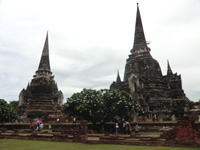
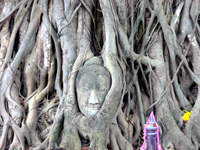
Ayuthaya, very famous for many of the world's treasures, is about 76km north
of Bangkok. In 1351 the city was established as the capital under
the Uthong Dynasty, and until it was razed by Burmese military in
1767, 33 different kings reigned over Ayuthaya as the center of
Thailand. About 20km before getting to the center of Ayuthaya is
Bang Pa-In Palace, our first stop. Bang Pa-In Palace was built in
1637 by Prasat Thong, the 24th king of the Ayuthaya Dynasty and
was used as a summer residence by succeeding kings until it was
damaged by the Burmese military in 1767. After that, it was left
vacant. However, during the Chakri Dynasty, King Rama 4th and 5th
restored it to its current state. The imperial villa contains five
buildings called pavilions that are situated within the premises.
Each one of the five is built in the architectural style of England,
France, China, etc. for a very eclectic feel of summer residence.
From there, it takes about 20 minutes to get to the center of Ayuthaya,
which is home to several of the world's wonders, especially shrines
and temples. The structure, made of stone, has weathered significantly
over the 700 years since it was built. Furthermore, aside from natural
weathering, Burmese military also caused considerable destruction
so in some places it's hard to determine what the structure looked
like while others still have the original shape. Many of these relics
end in the name "wat" which means "temple" in
Japanese. The temple in the picture at the left is a major temple,
Wat Mahathat which was built out of gold in the 13th century. The
face of the Buddha among the roots of the trees is part of the statue
of Buddha and is all that remains of the foundation of a chapel.
In the 16th century, this area of Ayuthaya was also a place of commerce
bringing visitors from many western countries particularly Portugal,
England and France, as well as other Asian countries such as Vietnam,
Malaysia, China, and Japan.
In order for Japanese traders to export good that were purchased and
warehoused in Thailand to the Japanese mainland, they established
a Japan town. At the highest point of growth, as many as 2,500-3,000
Japanese people lived in Ayuthaya.
The bus to Ayuthaya took over two hours but since we had a lunch cruise down the Chao Phraya River back to Bangkok, the return trip was 3.5 hours. I think I got my first real experience with authentic Thai food when we had to select from a variety of different dishes crammed in together on the boat.
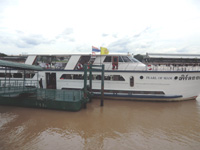 |
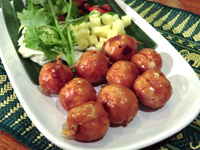 |
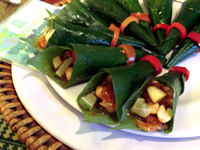 |
HOME > What’s New > Today's Notables > Details














